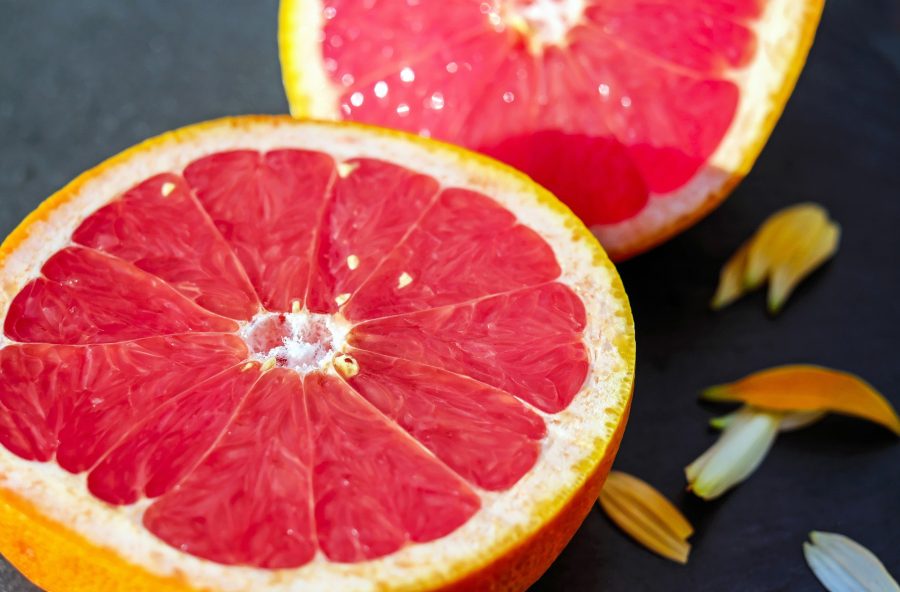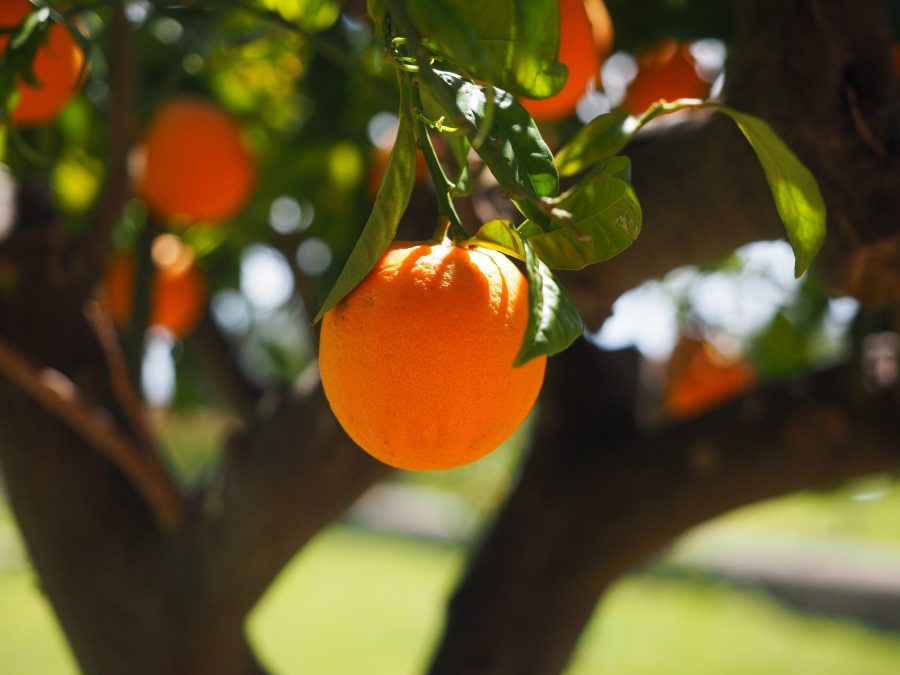Local fruit may be scarce this time of year, but seasonal citrus from warmer climates offers fresh flavor to help us refresh and slim down after the heaviness of winter and holiday fare. Most citrus is at its peak *right now,* so stock up and enjoy!
All citrus is loaded with the antioxidant powerhouse vitamin C as well as complementary bioflavonoids that help vitamin C work better in the body. Citrus lends a “degreasing” property to meals, helping you better digest fats. Freshly squeezed citrus – whether tart or sweet – immediately livens up the flavors in a dish with few calories added. Grate the zest (always use organic!) from the outer peel to flavor soups, dressings, marinades, and desserts. The bitterness of the peel primarily comes from the white pith, which is easily removed for recipes even though it’s loaded with healthy bioflavonoids.
I grew up loving fresh citrus from my grandparent's backyard trees in Florida. We'd enjoy grapefruit for breakfast while visiting, still warm from the sun. My grandfather (not one for sitting still) gathered excess fruit from his neighbors, hand peeled and juiced, and put the sliced fruit in clean milk jugs to freeze. When my travel-loving grandmother came to visit, there was always a well-packed case of frozen fruit that arrived with her on the plane.
Your store's exact selection of citrus varies day to day depending on what’s available, prices, and quality; however, here’s a primer on some of the common and specialty citrus you might find at the at the store on a given day. Be sure to keep an eye out for good deals on bagged citrus! My personal favorites are cara cara, blood orange, red grapefruit, clementines, satsumas, and the staple lemons (especially Myer, when available) and limes. Even though blood orange and cara cara are not as sweet, I love the posh color they bring to my day. Organic citrus peels can be saved to use fresh or dried as digestive bitter tonics as well (bitter flavors help regulate appetite and blood sugar while stimulating digestion and detoxification).
Navel Oranges (Citrus × sinensis) are the “gateway” citrus for most of us. Affordable, sweet, tasty, seedless, and usually easy-to-peel, navels are a simple snack or salad ingredient. They’re easily identified by their telltale navel belly buttons. Look for fruits that feel heavy (they’re juicier) and are completely orange without any greening of the skin, which indicates that they’re not fully ripe. Smaller navels generally taste better.
Cara Cara Orange (Citrus sinensis 'Cara Cara') is a variety of navel with pink flesh. The mutation was discovered in Venezuela. It's sweet (often a little less sweet than a traditional navel or clementine), seedless, with very little pith. It offers unique, subtle notes of grapefruit, rose, and blackberry. Unlike the blood orange, whose extra pigment comes from anthocyanins, the cara cara's pigment is from carotenoids like lycopene.
Valencia Oranges (Citrus sinensis 'Valencia') are prized for juicering. They’re loaded with seeds and are more difficult to peel, but they’re usually sweeter, more flavorful, and less expensive than navels. Use a good hand-juicer or throw them into a standard juicer after slicing off the peel: cut the ends off, then slowly slice down the strips off the side. Valencia peels may turn greenish in warm weather. Unlike navels, this usually indicates a sweeter, riper fruit.
Satsumas (Citrus unshiu) are one of the most delightful types of citrus, and the small fruits are worth the extra cost. Much like their relative mandarin oranges and clementines, satsumas are easy-to-peel, usually seedless, and super sweet. The flesh has a delightful a candy-like floral undertone. They’re delicious as a simple dessert of sections served alongside dark chocolate. Save some of your peels to dry and add to potpourri and tea. Look for fresh fruits with bright orange, plump peels that hasn’t gotten too mushy or hard – sure signs that they’ve been sitting on the shelf too long. Get a bunch. Even though they have a shorter shelf life, you can easily eat two to four in a sitting!
Clementines (Citrus × clementina) come in the big box, a classic for a quick snack. Easy-to-peel, seedless, sweet, and perfect for kids! Watch out for mushy and moldy fruits, though.
Blood Oranges (Citrus × sinensis 'Blood orange') are rich in anthocyanins, the red-purple pigment that gives them their bloody hue and enhanced antioxidant properties. Blood oranges may have orange or red-tinged skin; red skin usually indicates redder flesh. The flesh can range from deep red throughout to tie-dyed orange and red. They’re slightly bitter and tend to be harder to peel. Serve them as slices or segments with the pith removed to show off their color in gourmet salads like arugula with manchego cheese, or as a dessert sprinkled with cinnamon. Try freshly squeezed blood orange juice as dressing for roasted beets and chèvre on mesclun greens. The blood orange season can extend all the way into May.
Tangelos (Citrus × tangelo) are a hybrid, usually of tangerine and grapefruit, and they have vivid orange flesh with a knob on the end. They’re a bit larger, somewhat sweeter, and have just a few seeds. I must admit, I don't really like them.
Tangerines (Citrus tangerina) are smaller, deliciously sweet citrus that are usually easy to peel but may have a lot of seeds. The flavor tends to be brighter and less tart than other oranges.

Red Grapefruit (Citrus × paradisi) is sweeter, pinker, and much more common than white grapefruit nowadays. The flesh is tart and somewhat sweet, but the white pith is very bitter. Bitter and sour flavors both stimulate digestion while regulating blood sugar and appetite -- a benefit of grapefruit, especially alongside antioxidant- and grease-cutting aromatics and high-fiber pectin. Slice it up as a snack after meals. I find this really helps curb dessert cravings! If they’re too tart for you, drizzle with honey or sugar, or warm a bit and try maple syrup. Toss the fresh fruit or juice into avocado, salmon, chicken, and shrimp dishes or marinades. Enjoy sliced rounds or wedges in seltzer or cocktails. Grapefruit can be made like a tincture into bitters to add to cocktails and seltzer, too.
Lemons (Citrus × limon) provide classic tang for salad dressings and Italian dishes, especially when added just before serving. Bakers love to add the fresh juice and zest to recipes, too. Seek out Meyer lemons when available, which were made famous by gourmand Alice Waters and Chez Panisse. Meyers are a cross of lemon with orange or mandarin. They’re sweeter with none of the bitterness of a standard lemon, and their tender, bright yellow peels can be eaten straight or candied. I enjoy eating fresh slices and also throw wedges of any kind of lemon into ginger tea with honey on cold, dreary days.
Limes (various species and varieties) with their unique sour flavor and aromatic oils, are crucial for Mexican, Caribbean, and south Asian cuisine. The zest and fresh juice are used in meat marinades or added at the end of cooking to curries and soups for fresh flavor. They marry well with spearmint, cilantro, and coconut. Wedges are essential for mojitos and Mexican beer.
Clinical herbalist Maria Noël Groves sees clients and teaches classes at Wintergreen Botanicals Herbal Clinic & Education Center in Allenstown, New Hampshire.
The statements made on this blog have not been evaluated by the FDA and are not intended to diagnose, prescribe, recommend, treat, cure, or offer medical advice. Please see your health care practitioner for help regarding choices and to avoid herb-drug interactions.
A version of this blog originally appeared on the Concord Food Co-op site and has been reprinted with permission.
Photo Credits:
Orange Tree header - Image by Hans Braxmeier from Pixabay

